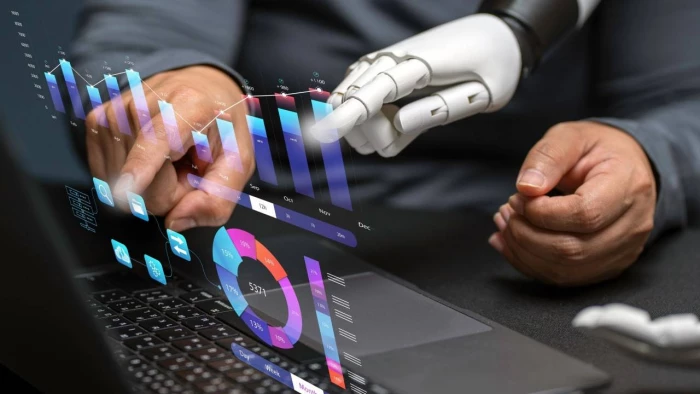

Discover how AI reshapes corporate strategy — from predictive analytics to smarter decision-making, driving agility, innovation, and long-term competitive advantage.
In the last decade, artificial intelligence (AI) has moved from a theoretical concept into a practical and indispensable instrument of strategic management. Today, it’s not only about automating processes or crunching data faster — AI is fundamentally reshaping how leaders design strategies, forecast the future, and make executive decisions. The shift from reactive management to proactive, data-driven decision-making marks one of the most profound transformations in modern business history.
For centuries, corporate strategy has relied on human intuition, experience, and partial data. Executives made decisions based on market reports, customer feedback, and economic indicators, often limited by time and cognitive bias. AI changes this dynamic completely.
Machine learning algorithms can now analyze millions of variables simultaneously — from consumer sentiment and competitor pricing to global supply-chain trends — identifying correlations invisible to the human eye.
A 2024 McKinsey Global Survey found that 61% of executives already use AI to inform strategic decisions, and those who do report an average 20% improvement in decision accuracy and forecasting reliability. AI doesn’t replace intuition; it amplifies it with evidence.

Predictive analytics lies at the core of AI-driven strategic planning. By examining historical data, AI systems model potential future scenarios with stunning precision.
Take Amazon as an example: its anticipatory shipping model predicts what customers will buy before they even click “add to cart,” enabling faster delivery and optimized inventory. Similar forecasting principles are now used in B2B sectors, energy markets, and financial modeling.
For strategic managers, predictive analytics answers fundamental questions:
The capacity to simulate multiple futures allows leadership teams to minimize uncertainty and align resources with the most probable success paths.
While predictive analytics focuses on the what, cognitive AI engines address the why and how.
Modern AI platforms can interpret qualitative factors — such as social sentiment, leadership culture, and geopolitical news — and integrate them into quantitative models.
For example, IBM’s Watson Decision Platform for Agriculture doesn’t just predict weather outcomes; it recommends specific strategies to improve yields. In corporate environments, similar decision engines combine structured (financial, logistical) and unstructured (media, public opinion) data to support board-level planning.
A notable shift here is scenario simulation. Rather than making a single strategic plan, AI allows executives to test hundreds of “what-if” models — each reflecting different assumptions about inflation, regulation, or competitor actions.
This method reduces the dependency on gut instinct and enables evidence-based agility.
In dynamic markets, speed of decision-making can determine survival. AI-assisted systems enhance organizational agility by automating parts of the analysis and surfacing insights in real time.
Consider how Unilever applies AI for global resource allocation. Their system monitors product performance across regions and automatically recommends budget reallocation based on shifting demand patterns. As a result, decision cycles that once took weeks now occur in hours.
Moreover, AI enhances cross-functional collaboration. Through shared dashboards and predictive indicators, marketing, operations, and finance can act from the same data foundation — creating strategic alignment that once required months of meetings.
Despite fears of automation, AI’s true value in strategy lies not in replacing executives but in augmenting them.
The “augmented executive” combines human creativity, empathy, and ethical judgment with AI’s analytical precision.
Studies from MIT Sloan (2023) suggest that hybrid decision-making — where humans validate AI-generated insights — yields up to 30% better strategic outcomes than human-only or AI-only approaches.
Here, AI serves as a trusted advisor. It identifies hidden risks, evaluates trade-offs, and quantifies opportunity cost, but final decisions remain guided by human vision and values.
In practice, corporate strategists often combine AI modeling with specialized analytical software.
For instance, when assessing merger opportunities or pricing elasticity, managers may use dedicated platforms like Math AI Helper — an analytical engine that supports complex probabilistic reasoning and pattern recognition.
Such tools bridge the gap between raw data and strategic clarity. They help translate statistical output into actionable business narratives, which is precisely where many organizations struggle. The seamless use of these analytical assistants marks a turning point in how strategy teams operate day to day.
With great analytical power comes greater responsibility. As AI systems influence billion-dollar decisions, questions of ethics, transparency, and bias become paramount.
Strategic AI models are only as fair as the data that trains them. A biased data set can misguide investment decisions or perpetuate inequality in market access.
This is why companies like Microsoft and Google have developed internal AI Governance Boards — interdisciplinary teams ensuring model transparency, auditability, and alignment with ESG principles.
Furthermore, ethical AI fosters stakeholder trust. Clients and investors are increasingly demanding to know how data-driven decisions are made and whether they respect privacy and fairness standards.
Embedding AI ethics into corporate governance is no longer optional; it’s a strategic necessity.
AI cannot thrive without robust data infrastructure. Organizations pursuing AI-driven strategy must prioritize:
For example, global logistics firms like Maersk built AI control towers—data hubs aggregating real-time shipping, weather, and customs information—to optimize routes dynamically.
The return on investment was immediate: 15% reduction in transit times and significant cost savings.
Such infrastructure transforms data from a static resource into a living strategic asset.
Looking ahead, we are approaching the era of autonomous strategic systems — AI platforms capable of continuously monitoring, modeling, and even executing tactical adjustments without human initiation.
These systems use reinforcement learning to test micro-strategies and refine their own algorithms. While still in early stages, industries like finance and logistics already experiment with self-optimizing models that detect inefficiencies and correct them autonomously.
In the next five years, the most competitive firms will be those that combine autonomous AI processes with human oversight, ensuring both speed and accountability.
A compelling case comes from a European manufacturing conglomerate that implemented an AI strategy suite to advise its board.
The system analyzed over 500 internal and external variables — from raw material prices to social media sentiment — and generated three scenario clusters for quarterly planning.
Within six months, the company reported:
The board now uses AI dashboards during every strategic meeting, transforming their culture from retrospective to predictive.
Strategic leaders must evolve alongside AI. The role of the executive now demands:
Top MBA programs, including Wharton and INSEAD, already include AI-augmented decision-making in their curricula, reflecting a recognition that tomorrow’s leaders must speak both “strategy” and “data science.”
The leaders who master this dual fluency will hold a decisive advantage in global markets.
The future of corporate strategy will not be written by machines alone, nor solely by human visionaries. It will emerge from their synergy.
AI brings precision, scale, and foresight; humans bring creativity, empathy, and moral reasoning. Together, they form a hybrid intelligence system capable of navigating unprecedented complexity.
By 2030, strategic management will look less like static annual planning and more like continuous, AI-supported adaptation. The companies that embrace this evolution today are those most likely to define tomorrow’s economy.
In conclusion, AI is not just an operational tool; it is a strategic partner. Those who understand how to leverage it responsibly and intelligently will lead the next wave of global innovation — from forecasting the future to shaping it.
Be the first to post comment!